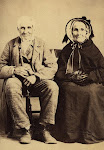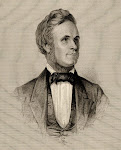by Janet S. Porter
Rachel, born June 7, 1809 at Sherborne, Hampshire, was the daughter of William and Hannah (Moss) Jennings. The Jennings family was well known at the time for their iron works and for their ingenious repair of “Big Ben,” the great clock in London. Raised in an environment of hard work and ingenuity, Rachel became a factor in the raising of an equally hard-working, ingenious family. She may not have known how to read or write in her youth, but she knew how to raise educated, industrious children.
Living in Rotherwick, William Junior and Rachel became the parents of three daughters when William’s mother Ann died there in 1834 at the age of 48. William Senior died six years later in 1840. Previously an agricultural laborer or perhaps because of family influence, William was able to secure a job with the Manor of Lord Thomas French, which was quite an advancement. It seems likely that his prominent family may have owned the land on which he had worked for such a promotion. For at least six years he served as gamekeeper for the manor, appearing in the 1841 census as a gamekeeper living on Hold St. and this time by his preferred name of William Stiff. Looking after and providing for the game on the manor estate so the village gentry could enjoy fox and duck hunts there, he apparently also worked on “Rotherwick Ridges,” as a carpenter at one time.
When these jobs ended, William and Rachel moved from Rotherwick in 1848, at which time they had four sons and four daughters. The names of these children provide a window into their lives. Since neither parent could read, perhaps it was all an accident. In 1836 their first son William was born and christened William Nevill.” When the fifth child Hannah or Annie was born she was christened “Hannah Nevill.” But listed in civil recorded as “Hanna Stiff”. The rest of the children were christened under the surname “Stiff.” These were small towns and no doubt the confusion began when local church members refused to forget William’s “base” birth. Or perhaps his rich relatives insisted that he remember his place at the bottom of their favored few. William appears to have held true to his Stiff beginnings, but in time the children began to take on the name Neville (pronounced in England NEV’L.)
It didn’t appear to be a decision as much as a process. They would be christened “Stiff” and then some of the, particularly the men, would appear on a later record as “Neville”. In the beginning the name of Stiff was a symbol of pride. The story was told of Sir William in English history who was on the Isle of Wight off the shore of Southern England. He began to cross a lagoon or marsh on a makeshift log bridge just as another knight in armor, leader of the King’s entourage, also began to cross the bridge. Sir William jostled for his footing until the knight was knocked off the bridge. Since the whole jostle was witnessed by the Kind, who happened that day not to be mad that his knight was pushed aside, name William Sir Stiff for being unconquerable. From then on the family took great pride in the name. Yet as time passes, the name just naturally evolved when the males in the family chose to be called Neville. As one example, the son of William and Rachel, William had taken the name Neville at the age of 22 when the 1861 census was taken; although his brother Charles next door was know by the surname Stiff at that time. However, by the 1881 census Charles had also taken the name of Neville.
Perhaps it was the symbol of a breaking with the past. Each son who took the Neville name became independent and productive, a significant contributor to society around him. When the brothers who came to America changed their name, some of them also wished to have the name pronounced a certain way. Joseph Hyrum’s family tells the following story.
“The capital V in NeVille is the carry-over from Grandfather Joseph Hyrum NeVille who generally used the capitalized V to emphasize the pronunciation N’Ville instead of Nevel.” Some didn’t go along with the change is spelling, and a family poem was written”
“Mrs. Nevel, beat the Devel,
How does your garden grow?
With cockle shells and Rosemary bells,
and pumpkins all in a row.”
But whatever the children chose to call themselves, without a doubt they were well on their way to become educated, productive people. Even William and Rachel likely worked to improve themselves because it is known that they later learned to read and write. The family simply didn’t like to stand still very long.
Apparently William found another job as gamekeeper for a local gentleman because in 1848 they moved ten miles south of Rotherwick to a called Bradley. Bradley was nothing more than a designation of 960 acres, 25 houses and about 100 people, soon to become 110. Having lived a few miles from the smoky industrial city of Basingstoke for most of their lives, they must have found Bradley a welcome and quiet change. In the 1851 census he and Rachel were 47 and 41 years old, he was a gamekeeper, and they had five children living at home. The two oldest children at home were Hannah, or Annie, age 12 (the names were interchangeable then,) and William, 14 years old. The oldest daughter Elizabeth, 23 and the next two daughters Sarah, age 20 and Rachel, age 18, and were apparently out of the home working.
Subscribe to:
Post Comments (Atom)









No comments:
Post a Comment